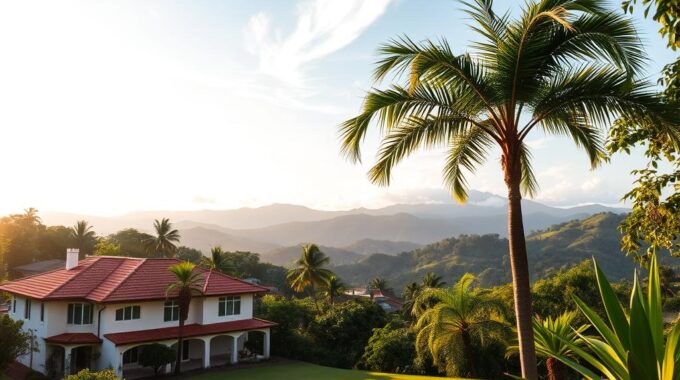As a hub for international workers and service providers, Costa Rica has introduced Law No…

Bank Deposit Requirement for Costa Rica Rentista Residency
Obtaining residency in Costa Rica is a dream for many, thanks to its stunning biodiversity and welcoming culture. One of the most accessible pathways is the Rentista Residency, which offers a unique option for those without a steady monthly income.
With over 20 years of experience, Costa Rica Immigration Experts (CRIE) simplify the process. They guide applicants through the financial and legal steps, ensuring a smooth journey. The $60,000 deposit alternative is a game-changer for many, making residency more attainable.
This guide will walk you through the essential aspects of the Rentista Residency process. From financial requirements to necessary documents, you’ll find everything you need to know. With expert assistance, securing your place in this beautiful country has never been easier.
Introduction to Costa Rica Rentista Residency
Costa Rica’s Rentista Residency offers a unique opportunity for those seeking a life in this tropical paradise. This program is designed for individuals who want to enjoy the country’s natural beauty and relaxed lifestyle without the need for employment. It provides a flexible pathway to establishing legal residency, making it an attractive option for many.
Overview of the Rentista Program
The Rentista program requires applicants to demonstrate a steady income or provide an alternative financial option. This ensures that individuals can support themselves while living in Costa Rica. The program is ideal for those who value freedom and want to explore the country’s rich culture and environment.
The Role of Costa Rica Immigration Experts (CRIE)
With over 20 years of experience, Costa Rica Immigration Experts (CRIE) are a trusted resource for navigating the residency process. Their team offers personalized consultation services, guiding applicants through every step. From understanding financial requirements to preparing documents, CRIE ensures a smooth and stress-free experience.
Understanding the Bank Deposit Requirement for Costa Rica Rentista Residency
The $60,000 deposit is a practical solution for meeting residency criteria. This lump-sum option provides an alternative to proving a steady monthly income, making it ideal for those with savings but no regular earnings.
What the $60,000 Deposit Entails
Applicants must maintain this amount in a local account for at least two years. This ensures financial stability and meets the program’s financial requirement. The process is straightforward and requires minimal documentation, such as bank statements.
Benefits of the Lump-Sum Option
This method offers several advantages:
- Simplifies the application process by reducing paperwork.
- Provides flexibility for those without a steady income.
- Eliminates the need to prove monthly earnings.
For many, this option is a more accessible path to residency. It reduces complexities and streamlines the approval process, making it a popular choice among applicants.
Financial Obligations and Income Alternatives
Applicants have two main options to fulfill the financial criteria for residency. The traditional route requires proving a steady monthly income, while the alternative involves a one-time lump-sum deposit. Both pathways are designed to ensure financial stability and meet the program’s requirements.
Monthly Income vs. Lump-Sum Options
The standard route involves demonstrating a monthly income of at least $2,500 for two years. This option is ideal for those with a steady source of earnings. Applicants must provide bank statements or other financial documents to verify their income.
Alternatively, the lump-sum option allows applicants to deposit $60,000 in a local account. This amount must remain untouched for two years. This method is particularly beneficial for those without a regular income but with sufficient savings.
Both options have their advantages. The monthly income route is straightforward for those with consistent earnings. The lump-sum alternative offers flexibility and reduces the need for ongoing documentation. Applicants can choose the option that best suits their financial situation.
Documentation plays a key role in both pathways. For the monthly income route, applicants must provide proof of earnings. For the lump-sum option, bank statements showing the deposit are required. Proper preparation of these documents ensures a smooth application process.
Ultimately, the choice between the two options depends on individual circumstances. Those with a steady income may prefer the traditional route. Others might find the lump-sum alternative more convenient. Both pathways are accepted, providing flexibility for applicants.
Step-by-Step Residency Application Process
Navigating the application process for residency can seem daunting, but breaking it into clear steps simplifies the journey. With expert guidance, applicants can ensure accuracy and efficiency at every stage. This section outlines the essential steps, from gathering documents to final submission.
Gathering Essential Documents
The first step involves collecting all necessary paperwork. Key documents include birth certificates, criminal records, proof of income, and passport photos. Each document must be apostilled or certified, depending on its origin.
Accuracy is critical. Missing or incorrect paperwork can lead to delays. Working with professionals ensures that all documents meet the required standards. This preparation sets the foundation for a smooth application process.
Submission and Follow-Up Procedures
Once documents are ready, the next step is submission. Applicants must file their paperwork with the immigration office and pay the required fees. Timely submission is essential to avoid unnecessary delays.
After submission, follow-up is crucial. Regular communication with immigration authorities helps track progress. Professionals can assist in addressing any issues that arise, ensuring the process stays on track.
By following these steps and leveraging expert support, applicants can navigate the process with confidence. A well-organized approach minimizes stress and maximizes the chances of success.
Navigating Legal Requirements and Documentation
Understanding the legal requirements is a critical step in the application process. Proper documentation ensures compliance with immigration standards and prevents delays. Applicants must gather specific paperwork, including birth certificates and criminal records, to meet the criteria.
Non-Spanish documents require apostilles and certified translations. These steps validate the authenticity of the paperwork and ensure it meets local standards. Working with reputable legal services simplifies this process and reduces errors.
Apostille and Certified Translations
An apostille is a certification that verifies the authenticity of public documents. It is essential for documents issued outside the country. Certified translations are required for non-Spanish paperwork, ensuring clarity and accuracy.
Common documents that need these certifications include birth certificates and criminal records. These items must be prepared carefully to avoid delays. Proper preparation ensures a smooth application process.
CRIE plays a vital role in guiding applicants through this stage. Their expertise ensures that all documents meet the necessary standards. This support minimizes stress and maximizes efficiency.
Changes in legal requirements by category can impact the process. Staying informed about these updates is crucial. Applicants should verify the latest standards to ensure compliance.
Here are actionable steps to prepare legal documentation:
- Gather all required documents, such as birth certificates and criminal records.
- Obtain apostilles for documents issued outside the country.
- Secure certified translations for non-Spanish paperwork.
- Verify the accuracy of all documents before submission.
- Work with professionals to ensure compliance with local standards.
By following these steps, applicants can navigate the legal requirements with confidence. Proper preparation ensures a successful application process.
Processing Time and Maintaining Residency
Understanding the timeline for residency approval is crucial for planning your move. The process typically takes up to a year from submission to final approval. During this period, applicants must ensure all documentation is accurate and up to date.
Keeping your passport valid throughout the process is essential. Expired documents can lead to delays or even rejection. Regularly check the expiration date and renew it if necessary.
Application Processing Timelines
Initial processing can take several months, with the entire process often extending up to a year. Applicants should prepare for this timeframe and plan accordingly. Staying organized and proactive helps avoid unnecessary delays.
Maintaining legal status involves meeting annual obligations. These include filing returns and ensuring compliance with local regulations. Failure to meet these requirements can jeopardize your residency status.
Here are some tips to manage the process effectively:
- Track deadlines using a calendar or reminder system.
- Keep all documents organized and easily accessible.
- Work with experts like CRIE for timely updates and guidance.
CRIE professionals provide valuable support, ensuring applicants meet all necessary requirements. Their expertise simplifies the process and reduces stress, making the journey toward residency smoother.
Benefits of the Rentista Residency Program
Living in Costa Rica offers a unique blend of benefits that enhance quality of life. The Rentista program is designed to provide access to excellent healthcare, favorable tax conditions, and a relaxed lifestyle. These advantages make it an attractive option for retirees, investors, and families alike.
Healthcare, Tax Advantages, and Lifestyle Perks
One of the standout benefits of the Rentista program is access to Costa Rica’s high-quality healthcare system. Residents can enjoy affordable medical services and world-class facilities. This ensures peace of mind for individuals and families.
Tax advantages are another key perk. The program offers favorable conditions for retirees and investors, including exemptions on certain income and property taxes. These benefits make it easier to manage finances while enjoying a comfortable life.
Lifestyle perks include access to stunning beaches, lush rainforests, and a vibrant culture. The country’s natural beauty and welcoming community create an enriching experience for residents. Whether you’re retiring or starting a business, Costa Rica offers a fulfilling environment.
Pathway to Permanent Residency
The Rentista program also provides a streamlined pathway to permanent residency. After maintaining temporary residency for three years, applicants can apply for permanent status. This process is straightforward and offers long-term stability.
Many applicants find this option appealing because it eliminates the need for frequent renewals. It also opens doors to additional benefits, such as the ability to work or invest without restrictions. This flexibility enhances the overall experience of living in Costa Rica.
Real-life examples show how the program has transformed lives. Retirees enjoy a peaceful retirement, while entrepreneurs thrive in a business-friendly environment. These success stories highlight the program’s ability to improve quality of life.
In summary, the Rentista program offers a wealth of benefits. From healthcare and tax perks to a clear pathway to permanent residency, it’s a program designed to enhance life in Costa Rica. Whether you’re seeking relaxation or new opportunities, this program delivers.
Expert Consultation and Personalized Pricing

Expert guidance is a game-changer for those navigating the immigration process. Working with professionals like Costa Rica Immigration Experts (CRIE) ensures accuracy and efficiency. Their tailored advice simplifies complex steps, making the journey smoother.
Tailored Advice from CRIE Professionals
CRIE offers personalized pricing plans based on individual needs. Factors like family size and specific documentation requirements are considered. This approach ensures that each client receives a plan that fits their unique situation.
Here’s why expert consultation is essential:
- It helps avoid common pitfalls during the application process.
- Professionals ensure all documents meet legal standards.
- Tailored advice speeds up the overall process.
CRIE’s team provides dedicated support at every stage. From initial consultation to final approval, they guide clients through each step. This personalized approach minimizes stress and maximizes success.
To schedule a consultation, contact CRIE via call or WhatsApp. Their experts are ready to assist with customized plans and accurate pricing. Taking this step ensures a smoother and more efficient immigration experience.
Comparing Costa Rican Immigration Options
Choosing the right visa category in Costa Rica depends on your financial and lifestyle goals. The country offers several pathways, including the Rentista, Pensionado, and Investor visas. Each option has unique requirements and benefits, making it essential to understand the differences before deciding.
Rentista vs. Pensionado vs. Investor Visas
The Rentista visa is ideal for individuals with savings or alternative income. It requires a $60,000 deposit or proof of a $2,500 monthly income. This option is flexible and doesn’t require employment, making it popular among those seeking a relaxed lifestyle.
The Pensionado visa caters to retirees with a stable pension. Applicants must show a minimum monthly income of $1,000. This visa offers tax benefits and access to affordable healthcare, making it a great choice for retirees.
The Investor visa is designed for those looking to invest in the country. It requires a minimum investment of $150,000 in real estate or businesses. This option provides a pathway to residency while contributing to the local economy.
Financial Commitments and Benefits
Each visa has distinct financial requirements:
- Rentista: $60,000 deposit or $2,500 monthly income.
- Pensionado: $1,000 monthly pension.
- Investor: $150,000 investment in real estate or businesses.
Benefits vary by category. The Pensionado visa offers tax exemptions and healthcare perks. The Investor visa provides opportunities for business growth and property ownership. The Rentista visa is flexible and accessible for those without a steady income.
Selecting the Best Option
When choosing a visa, consider your financial situation and long-term goals. Retirees may prefer the Pensionado visa for its tax advantages. Investors can benefit from the Investor visa’s business opportunities. Those with savings might find the Rentista visa more suitable.
Understanding the differences between these options ensures you make an informed decision. Costa Rica’s diverse visa categories cater to various needs, making it easier to find the right fit for your lifestyle.
Success Stories and Client Experiences
The journey to residency in Costa Rica has transformed lives for countless individuals. Many applicants have shared their inspiring stories, highlighting the ease and benefits of the Rentista program. These real-life experiences showcase the positive impact of expert guidance and the program’s flexibility.
Real Journeys to Residency
One applicant, a retiree from the United States, found the process seamless with the help of Costa Rica Immigration Experts (CRIE). From gathering essential documents like birth certificates to navigating legal requirements, CRIE provided step-by-step support. This applicant now enjoys a peaceful life in a vibrant Costa Rican community.
Another success story involves a young entrepreneur who chose the Rentista program to start a business. With CRIE’s assistance, they overcame challenges like document translations and financial planning. Today, they thrive in a business-friendly environment, contributing to the local economy.
These stories highlight key milestones, such as document preparation and successful approval. Overcoming challenges during the process built confidence and stability in their new lives. The strong reputation of CRIE is evident in these real client experiences.
Overall, applicants report high satisfaction and an improved quality of life. Whether retiring or starting anew, the Rentista program offers a pathway to a fulfilling life in Costa Rica. These success stories inspire others to take the first step toward their dream.
Conclusion
The Rentista program simplifies the path to living in a vibrant and welcoming environment. It offers flexibility through both monthly income and lump-sum options, making it accessible for a wide range of applicants. The step-by-step process is transparent, ensuring clarity at every stage.
Expert guidance from CRIE plays a vital role in navigating the application process. Their personalized approach ensures accuracy and efficiency, reducing stress for applicants. With their support, transitioning to life in this beautiful country becomes a smooth and rewarding experience.
Take the next step toward your dream by scheduling a consultation with CRIE. Their tailored advice and pricing plans are designed to meet your unique needs. Start your journey today and discover the advantages of making this tropical paradise your home.


